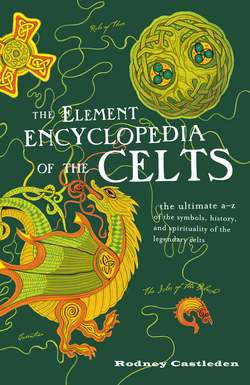Читать книгу The Element Encyclopedia of the Celts - Rodney Castleden - Страница 211
OGHAM
ОглавлениеSome of the ancient Celts used a strange alphabet that was developed specifically for making short inscriptions on standing stones. One edge of the standing slab was used as the writing line and short horizontal linear marks were made from this, to right or left or both. They were carved singly or in groups of up to five. In this way 20 different characters could be created.
The resulting alphabet was sometimes known as Beth Luis Nuin, after the (original) first three letters, just as with ABC for our modern Western alphabet. The surviving layout of the alphabet means that the system should logically be called Beth Luis Fearn (one, two, and three horizontal strokes to the right, respectively). The fact that the alphabet is known as Beth Luis Nuin shows that there was a still older Gaelic system, of which only the nickname has survived.
Because the basis of the alphabet was a vertical line and the characters were lines branching to left and right from it, the system was like a tree, and it is sometimes called the Ogham Tree. This idea led on to giving the characters the names of trees. Beth means “birch,” Luis means “rowan,” and Nuin means “ash.” The system is a tree; the alphabet itself is a forest. Individual trees held high symbolic significance, so the forest alphabet was deemed to be a repository of wisdom. The word for “knowledge” also means “wood.”
Inscriptions are read from the bottom up, the way a tree grows.
The name “Ogham” comes from the name of the Irish god Ogma, the god of poetry and learning who is said to have devised the alphabet himself.
It is likely the Ogham alphabet was used for writing on perishable materials such as wood, leather, and bark, but these have not survived. The inscriptions that have survived are all on stone and they all date from AD 300 to 700.
The intensification of agriculture in Ireland meant that many Ogham stones were threatened. Some were rescued and put on display at University College Cork; the West Wing Stone Corridor there houses the largest collection of Ogham stones in Ireland. These stones are a national treasure, in that they represent the earliest examples of writing in Ireland, unless we count the remarkable Neolithic symbols carved on the Boyne passage graves. Another collection of Ogham stones is housed at Mount Melleray monastery near Cappoquin in County Waterford.
Some of the standing stones were raised as boundary markers. Some, mainly the later ones, were raised to mark graves. Many of the surviving Ogham inscriptions have been translated to read “name of person + name of father + name of tribe.”
An Ogham stone from Ballymorereagh in County Kerry carries a Latin inscription on its face, which reads FECT QUENILOC, “Made by Qeniloc.” Along the edge is Qeniloc’s name and ancestry in Ogham.
Ogham was not confined to Ireland; Irish migrants took it to Wales.
